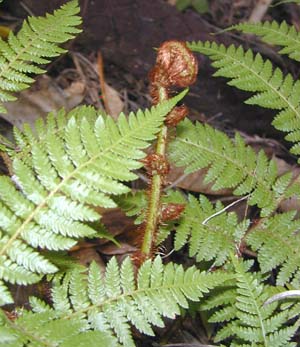고사리강
고사리강 또는 양치식물강, 박벽포자낭군 양치류(薄壁胞子囊群 羊齒類)는 현존하는 양치식물 중에서 가장 큰 분류군으로 전 세계적으로 약 9,000여 종을 포함하고 있다. 이 종들은 모두 양치식물아강(Polypodiidae)[1]을 구성하지만, 고사리강(Pteridopsida 또는 Polypodiopsida) 등으로 간주하기도 하며,[2] 기타 분류 체계에 따라서 다른 분류 등급으로 할당하기도 한다.[3] 박벽포자낭군 양치류는 4개의 주요 양치식물 분류군 중의 하나로, 다른 양치식물은 용비늘고사리류, 속새류, 솔잎란류와 고사리삼류 등이다.[1][2]
|
| ||
|---|---|---|
 나무 고사리 | ||
| 생물 분류ℹ️ | ||
| 계: | 식물계 | |
| 문: | 양치식물문 | |
| 강: | 고사리강 (Pteridopsida/Polypodiopsida) | |
| 목 | ||
| ||
박벽포자낭군 양치식물 종의 거의 1/3은 착생식물이다.[4]
이 양치류를 박벽포자낭군 양치류라고 부르는 까닭은 여러 개의 표지 세포로부터 발달하는 진정포자낭군 양치류(다계통군)이 아니라, 포자낭이 하나의 표피 세포로부터 발달하기 때문이다. 포자낭은 일반적으로 포자낭군(胞子囊群, sorus) 전체를 덮을 수 있는 포막(包膜, indusium)이라 불리는 비늘에 싸여 있으며, 이는 포장낭군 주변에 둥글게 또는 받침 형태를 취하거나 또는 크게 줄어들거나 완전히 사라져 있다. 대다수 박벽포자낭군 양치류는 포자낭 주변에 포자를 방출하는 고리 모양의 환대(環帶, annulus)를 가지고 있다.
하위 분류 편집
박벽포자낭군 양치류는 현존하는 방대한 대다수의 양치류를 포함하고 있다. 다만, 오래전에 분화된 진정포자낭군 양치류는 포함하지 않는다. 기본적인 분류 체계는 2006년 스미스(Smith) 외 공저자들 그리고 2011년 크리스텐휴즈(Christenhusz) 외 공저자들이 제안했다.[1]
- 고비목 (Osmundales)
- 고비과 (Osmundaceae)
- 처녀이끼목 (Hymenophyllales)
- 처녀이끼과 (Hymenophyllaceae) - Trichomanaceae 포함
- 풀고사리목 (Gleicheniales)
- 실고사리목 (Schizaeales)
- 생이가래목 (Salviniales)
- 나무고사리목 (Cyatheales)
- 고사리목 (Polypodiales)
- 론키티스과 (Lonchitidaceae)[1]
- 비고사리과 (Lindsaeaceae)
- 삭콜로마과 (Saccolomataceae)
- 키스토디움과 (Cystodiaceae)[1]
- 잔고사리과 (Dennstaedtiaceae) - Hypolepidaceae, Monachosoraceae, 고사리과(Pteridiaceae) 포함
- 봉의꼬리과 (Pteridaceae) - 아크로스티쿰과(Acrostichaceae), 악티니옵테리스과(Actiniopteridaceae), 공작고사리과(Adiantaceae), Anopteraceae, Antrophyaceae, Ceratopteridaceae, 개부싯깃고사리과(Cheilanthaceae), 북바위고사리과(Cryptogrammaceae), Hemionitidaceae, Negripteridaceae, 물고사리과(Parkeriaceae), Platyzomataceae, Sinopteridaceae, Taenitidaceae, 일엽아재비과(Vittariaceae) 포함
- 디플라지옵시스과 (Diplaziopsidaceae) X.C.Zhang & Christenh. 2011[6]
- 진정고사리군 II (Clade eupolypods II) in Smith 2006 (이전의 Blechnales, Athyriales, Aspleniales 또는 Thelypteridales)
- 한들고사리과 (Cystopteridaceae) Schmakov 2001
- 꼬리고사리과 (Aspleniaceae) Newman 1840
- 헤미딕티움과 (Hemidictyaceae) Christenh. 2011[6][7]
- 처녀고사리과 (Thelypteridaceae) Pic.Serm. 1970
- 라키도소루스과 (Rhachidosoraceae) X.C.Zhang 2011[1]
- 우드풀과 (Woodsiaceae) Herter 1949
- 야산고비과 (Onocleaceae) Pic.Serm. 1970
- 새깃아재비과 (Blechnaceae) Newman 1844 - Stenochlaenaceae 포함
- 개고사리과 (Athyriaceae) Alston 1956
- 진정고사리군 I (Clade eupolypods I) in Smith 2006
- 관중과 (Dryopteridaceae) - Aspidiaceae, Bolbitidaceae, Elaphoglossaceae, 금털고사리과(Hypodematiaceae), Peranemataceae 포함
- 덩굴고사리과 (Lomariopsidaceae)
- 줄고사리과 (Nephrolepidaceae)[1]
- 텍타리아과 (Tectariaceae)
- 올레안드라과 (Oleandraceae)
- 넉올레안드라과 (Davalliaceae)
- 고란초과 (Polypodiaceae) - Drynariaceae, Grammitidaceae, Gymnogrammitidaceae, 주걱일엽과(Loxogrammaceae), Platyceriaceae, Pleurisoriopsidaceae 포함
계통발생학적 관계 편집
아래는 관다발식물에 속하는 식물 강(綱)들과 박벽포자낭군 양치류 사이의 관계를 보여주는 분기도이다. 양치식물강이 용비늘고사리강,[8] 속새강,[6] 또는 일종의 용비늘고사리강-속새강 분기군[9]으로 추정되는 분류군과 자매군인지 여부는 분명치 않다.
다음은 2006년 스미스(Smith) 등과 2011년 리(Li) 등, 2013년 그레위(Grewe) 등의 연구에 기초한 계통 분류이다.[10][11][12]
|
진정포자낭군
양치식물 박벽포자낭군 양치식물 |
2016년 크리스텐휴즈(Christenhusz)와 채즈(Chase) 등의 연구 결과에 기초한 대안적 계통 분류는 다음과 같다.[13]
| 양치식물강 |
| ||||||||||||||||||
각주 편집
- ↑ 가 나 다 라 마 바 사 Christenhusz, M.J.M., Zhang, X.C. & Schneider, H. (2011). "A linear sequence of extant families and genera of lycophytes and ferns" Phytotaxa 19: 5-22
- ↑ 가 나 Smith, A. R., K. M. Pryer, et al. (2006). "A classification for extant ferns." Taxon 55(3): 705-731
- ↑ Chase, Mark W. and Reveal, James L. (2009년 10월). “A phylogenetic classification of the land plants to accompany APG III”. 《Botanical Journal of the Linnean Society》 161 (2): 122–127. doi:10.1111/j.1095-8339.2009.01002.x. 2011년 6월 7일에 원본 문서에서 보존된 문서. 2012년 5월 2일에 확인함.
- ↑ Schuettpelz, Eric. "Fern Phylogeny Inferred from 400 Leptosporangiate Species and Three Plastid Genes," contained in "The Evolution and Diversification of Epiphytic Ferns." Doctoral dissertation, Duke University. 2007. http://dukespace.lib.duke.edu/dspace/bitstream/10161/181/1/D_Schuettpelz_Eric_a_052007.pdf Archived 2010년 6월 20일 - 웨이백 머신
- ↑ Christenhusz, M.J.M. (2009). "New combinations and an overview of Cyathea subg. Hymenophyllopsis (Cyatheaceae)" Phytotaxa 1: 37-42
- ↑ 가 나 다 Samuli Lehtonen (2011). “Towards Resolving the Complete Fern Tree of Life” (PDF). 《PLoS ONE》 6 (10): e24851. doi:10.1371. 2012년 8월 8일에 원본 문서 (PDF)에서 보존된 문서. 2012년 5월 2일에 확인함.
- ↑ Christenhusz et al. (2011c) Christenhusz & Schneider: "Corrections to Phytotaxa 19: Linear sequence of lycophytes and ferns", (14 Sep 2011)
- ↑ Hardeep S. Rai & Sean W. Graham (2010). “Utility of a large, multigene plastid data set in inferring higher-order relationships in ferns and relatives (Monilophytes)” (PDF). 《American Journal of Botany》 97 (9): 1444–1456.
- ↑ Kathleen M. Pryer & Eric Schuettpelz (2009). 〈Ferns〉 (PDF). S. Blair Hedges & Sudhir Kumar. 《The Timetree of Life》. Oxford Biology.
- ↑ Smith, Alan R.; Kathleen M. Pryer; Eric Schuettpelz; Petra Korall; Harald Schneider; Paul G. Wolf (2006). “A classification for extant ferns” (PDF). 《Taxon》 55 (3): 705–731. doi:10.2307/25065646. JSTOR 25065646.
- ↑ Li, F-W; Kuo, L-Y; Rothfels, CJ; Ebihara, A; Chiou, W-L; 외. (2011). “rbcL and matK Earn Two Thumbs Up as the Core DNA Barcode for Ferns”. 《PLoS ONE》 6 (10): e26597. Bibcode:2011PLoSO...626597L. doi:10.1371/journal.pone.0026597. PMC 3197659. PMID 22028918.
- ↑ Grewe, Felix; 외. (2013). “Complete plastid genomes from Ophioglossum californicum, Psilotum nudum, and Equisetum hyemale reveal an ancestral land plant genome structure and resolve the position of Equisetales among monilophytes”. 《BMC Evolutionary Biology》 13 (1): 1–16. doi:10.1186/1471-2148-13-8. ISSN 1471-2148. PMC 3553075. PMID 23311954.
- ↑ Pteridophyte Phylogeny Group (November 2016). “A community-derived classification for extant lycophytes and ferns” (PDF). 《Journal of Systematics and Evolution》 54 (6): 563–603. doi:10.1111/jse.12229.